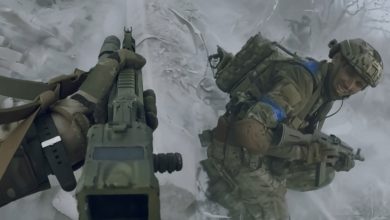Armed and Armored: Jeeps with Teeth

The Jeep is an enduring American icon. From 1941 through 1945, U.S. industry produced more than 600,000 of the standardized design of the “U.S. Army truck, 1⁄4‑ton, 4×4, command reconnaissance (Willys MB and Ford GPW). The incredible go-anywhere, do-anything light trucks served around the world with U.S. and Allied forces, and forever changed the expectations of what a military vehicle could achieve.
The compact, low-profile, four-wheel drive vehicle came from the design prowess of U.S. commercial automakers, primarily Ford, Willys and Bantam. Originally intended for the infantry, the Jeep quickly found its way to the U.S. Cavalry and the fledgling armored force. Looking at the faces of the troops using various Jeep prototypes in pre-war training, their smiles aren’t staged. No propaganda was necessary. Everyone knew the Jeep was a ground-breaking vehicle that delivered an advantage on the battlefield.
Just like the airplane in World War I, it wasn’t long before the Jeep mounted a machine gun. From its earliest days in service, the Jeep was acknowledged as a fast mover. G.I. ingenuity would make it a hard hitter as well.
Jeep with a Machine Gun
U.S. troops took one look at the new Jeep and immediately saw an opportunity to create a weapons carrier. Initially, .30-cal. Browning M1917 and M1919 machine guns were used atop slight variations of their standard infantry tripods, or improvised pedestal mounts. Soon after, U.S. Ordnance began to develop various mounts made specifically for the Jeep.
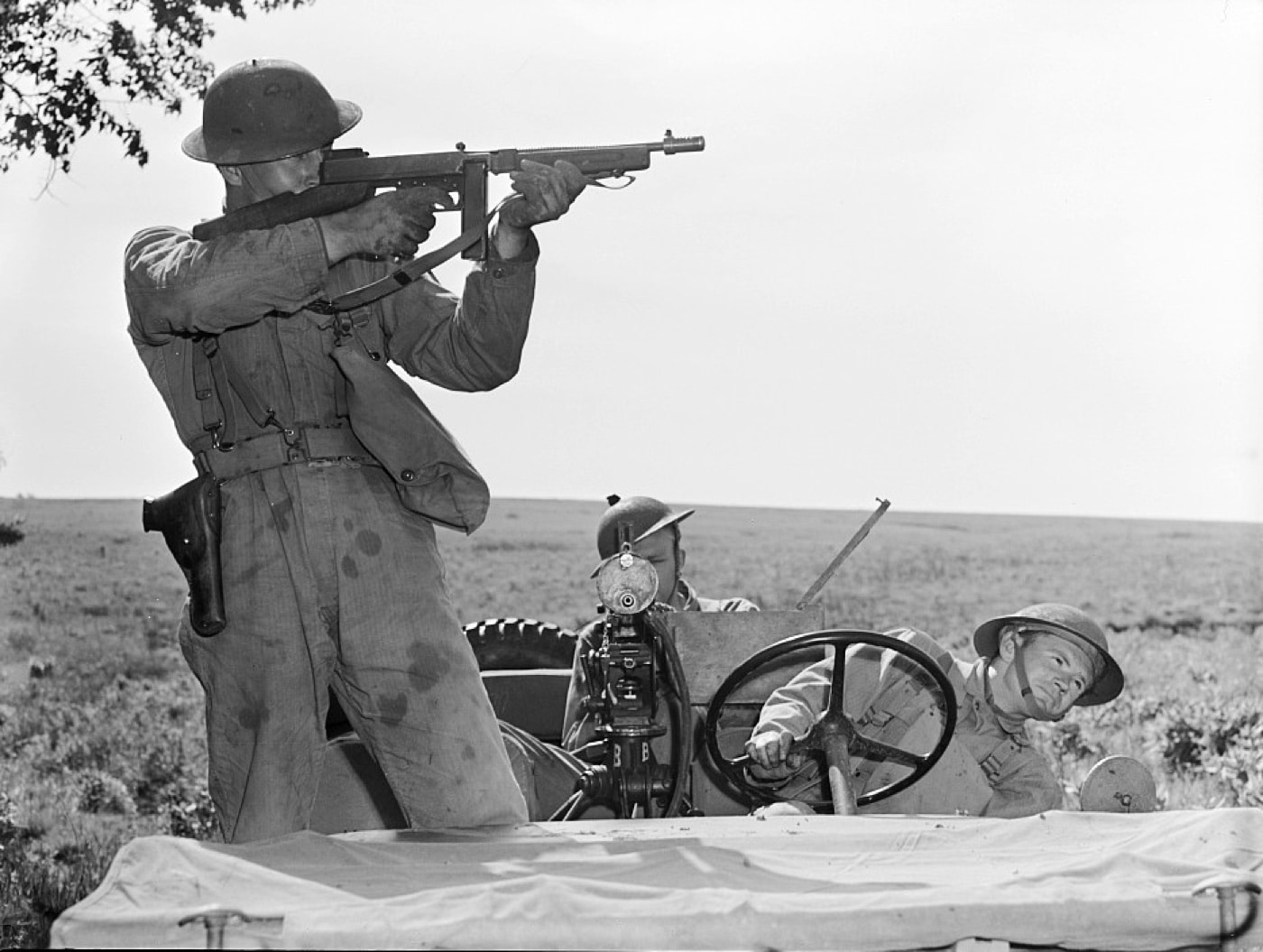
The big Browning .50-cal. M2 machine gun was a very effective infantry weapon, but it’s great weight (84 lbs. for the gun alone, 128 lbs. for the gun with its M3 tripod) greatly limited its use by foot soldiers. Mounted aboard the Jeep, the big .50-cal. MG was suddenly mobile and able to support the efforts of recon units.
The powerful recoil of the .50 had a significant impact on the ¼-ton Jeep. Consequently, sturdy mounts were required to maximize the potential of the big Browning gun and keep the heavy MG on target during full auto fire. There were several variations on machine gun pedestal mounts intended for the Jeep, along with the inevitable G.I. motor pool-expedients developed in the field.
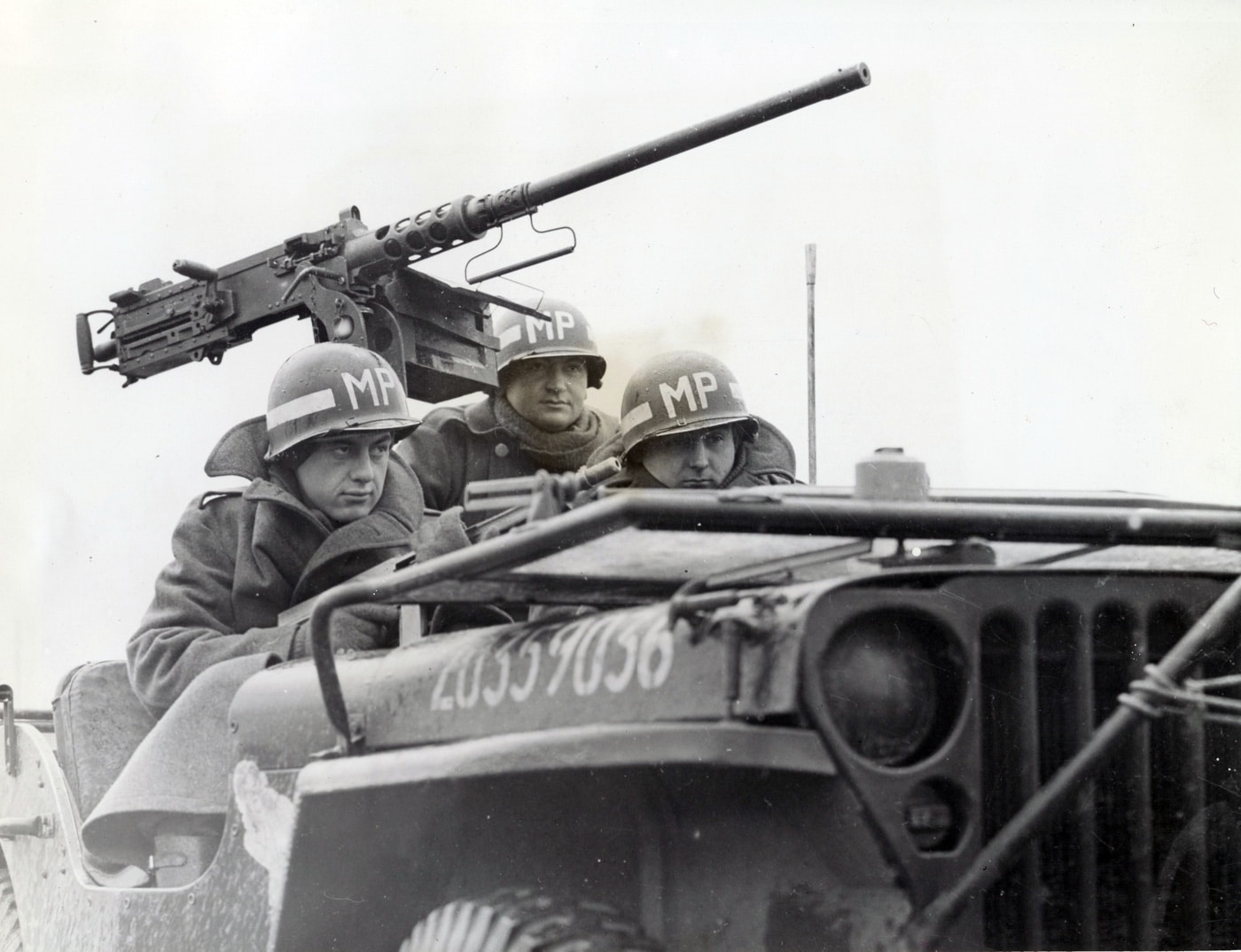
The following are some of the primary factory-designed gun mounts for the Jeep:
- T47 Pedestal Mount: The pedestal was bolted to the chassis, with the later triple-braced configuration becoming the production M31 series.
- The M31 Series Pedestal Mount: A pedastal for the .50 caliber Browning M2 machine gun. This pedestal allowed 85-degree elevation, and 25-degree depression of the MG.
- The M48 Bracket Mount: Designed for the Jeep dashboard, used primarily with the .30 caliber Browning M1919A4 and occasionally the M1918 Browning Automatic Rifle.
Jeep as a Tank Destroyer?
After Germany’s amazing blitzkrieg victory over France in the spring of 1940, the U.S. Army pursued a unique “tank destroyer” doctrine. The following search for an acceptable vehicle for the Army’s self-propelled TD battalions proved to be more complex than originally anticipated. Tank Destroyer Command soon realized they would have to make do with expedient designs that coupled existing vehicles and anti-tank guns.

The new four-wheel drive Jeep was considered as a candidate for the light tank destroyer role, armed with the M3 37mm gun. Proponents of the Jeep-based tank destroyer argued that the design would be simple and relatively inexpensive to produce. Also, because of its small size, the Jeep TD would be easy to conceal in the field — a major plus in a “shoot & scoot” type vehicle.
After field trials, it was quickly apparent that the added weight of the 900-lb. M3 gun, the 37mm ammo and the three-man crew (driver, loader and gunner), badly overloaded the ¼-ton Jeep. The engine overheated, breakdowns became frequent, and there was no room for onboard ammunition storage. The recoil of the 37mm gun was particularly hard on the chassis.
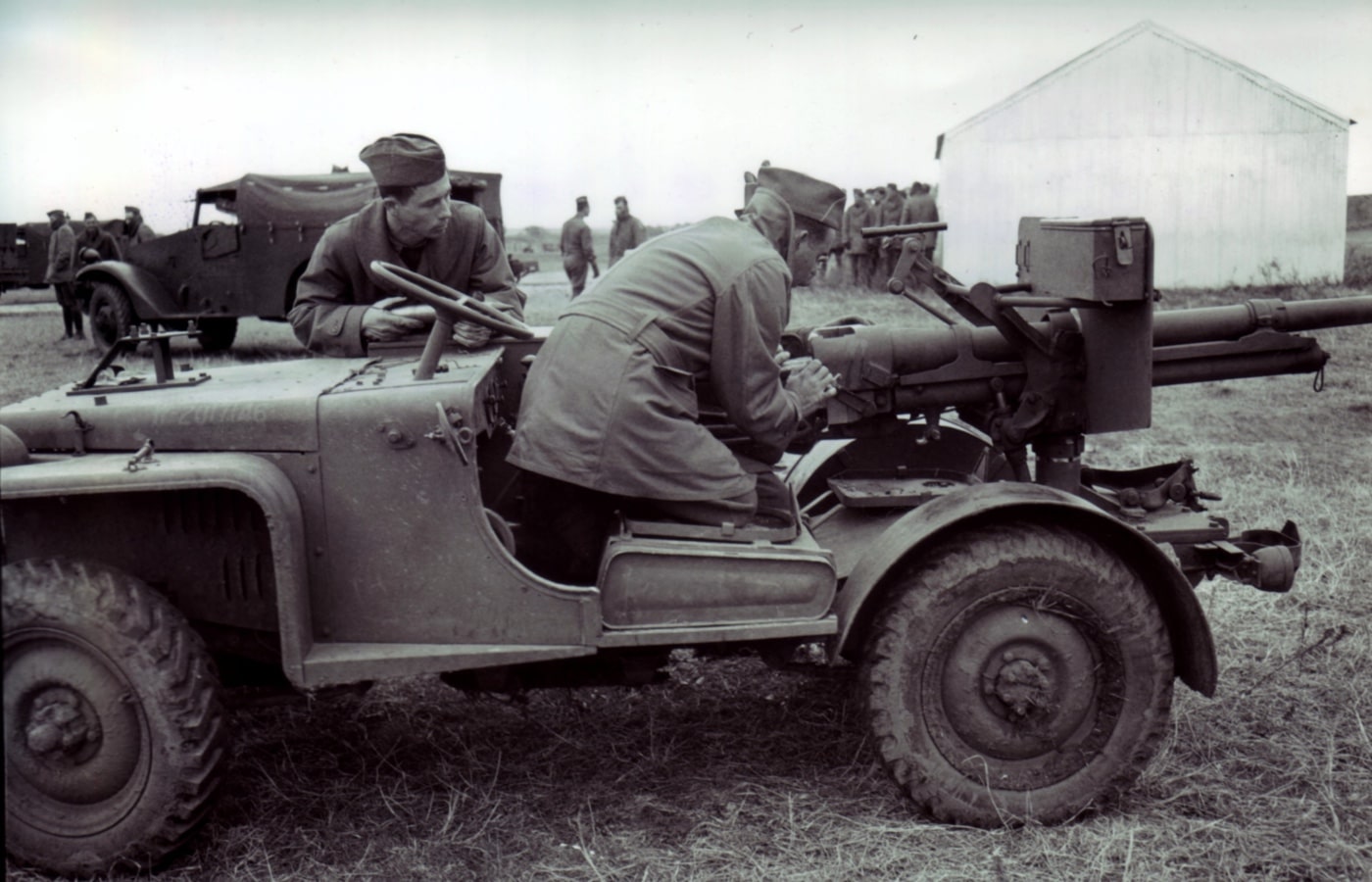
Ultimately, the Jeep tank destroyer never went beyond a few test vehicles, but it helped lead to more effective designs, like the M6 “Fargo” 37mm gun motor carriage.
Rocket-Launching Jeeps
As U.S. forces pressed into Germany in late 1944, a wide variety of expedients were developed to leverage the 4.5-inch M8 artillery rocket. The US 802nd Tank Battalion converted a few of their Jeeps into rocket launchers by using a 12-tube section of T34 rocket launcher. A thin armored roof, windscreen and back wall were added to protect the crew against the mighty backblast from the rockets when they were launched.
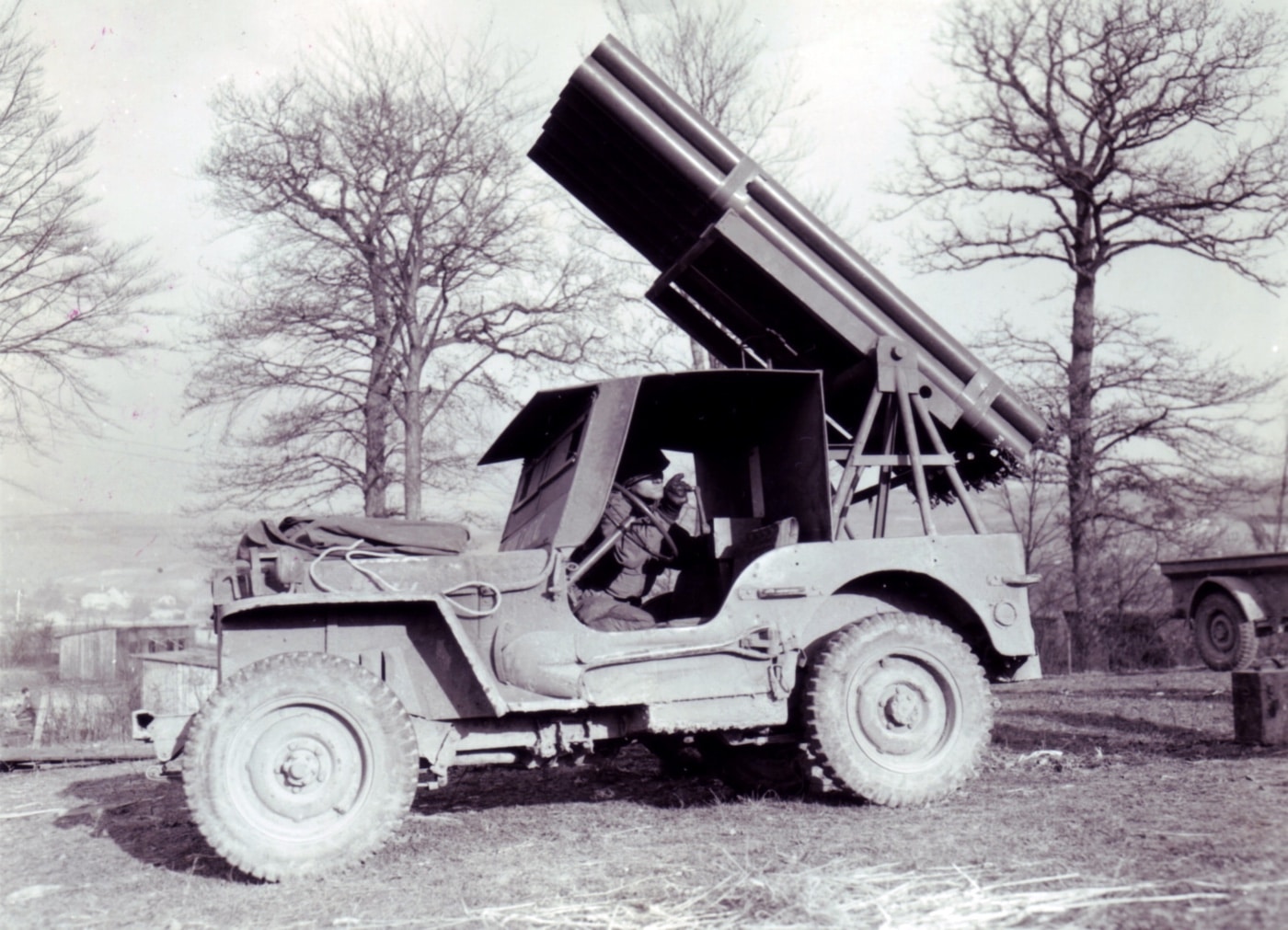
Another interesting “rocket-launching” Jeep conversion was the addition of a pair of 2.36-inch M1A1 Bazookas. G.I.s of the 9th Infantry Division came up with the idea in Germany during the winter of 1945.

To beef up firepower against German roadblocks and machine gun bunkers, two of the recoilless Bazooka anti-tank rocket launchers were seated side-by-side on a pedestal mount — creating an effective “shoot-and-scoot” weapon system for recon troops. The Jeep was fitted with a thin armored windscreen, like many reconnaissance vehicles, and the recoilless bazookas fired forward through a notched section in the armor.
Armed Jeeps in Action
As the war went on, armed and armored Jeeps became relatively commonplace in American recon units, with arming and armoring following some consistent patterns but without official orders or specifications for their creation and use. As for armor, thin plates, sufficient to stop enemy small arms fire, were added to replace the windscreen (when available). Adding armor was a delicate balancing act — trading a small amount of forward protection for significant weight.
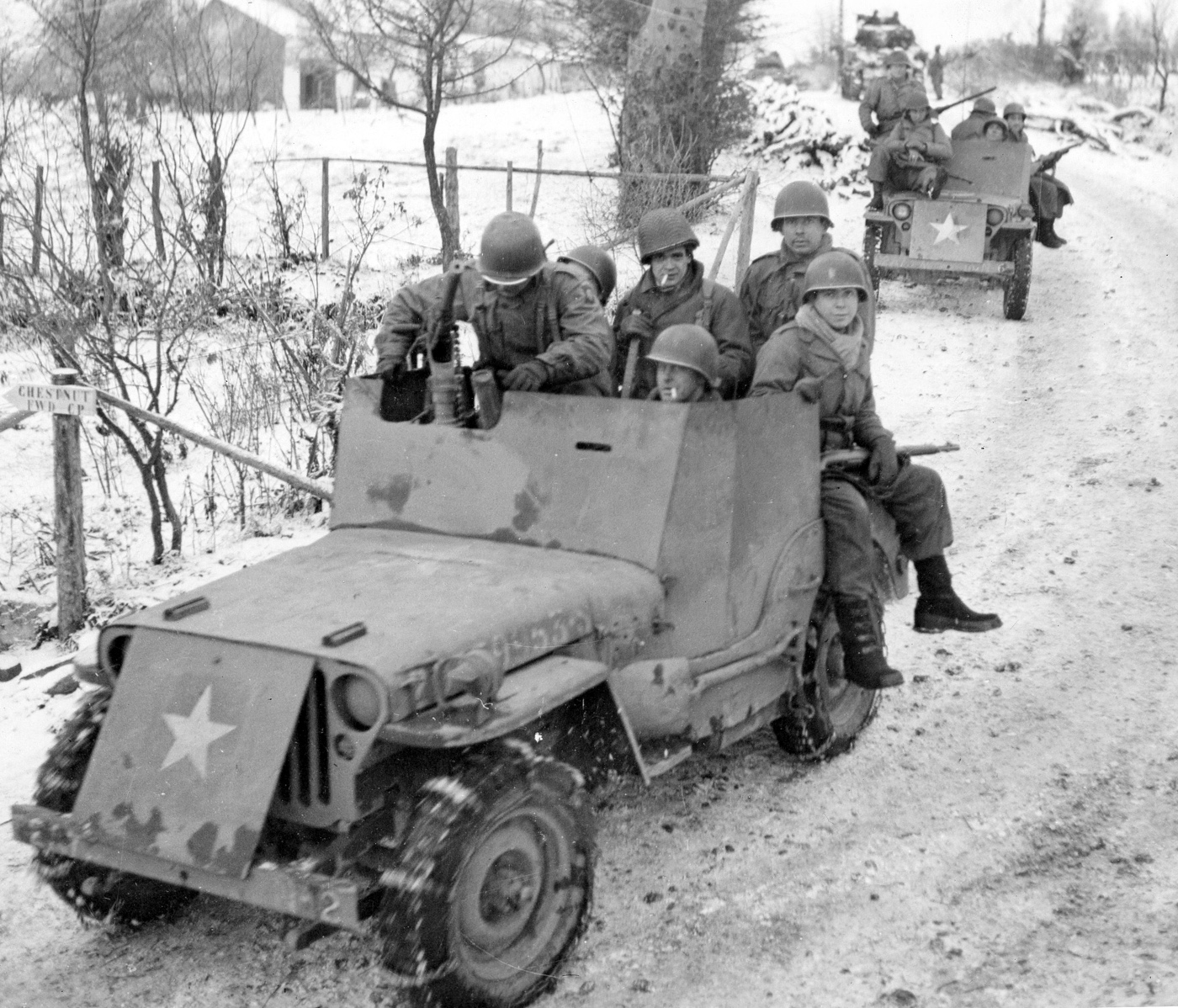
The following report was made to the Pacific Warfare Board on July 9, 1945, by the 32nd Cavalry Reconnaissance Troop (Mechanized) of the 32nd Infantry Division. This provides some interesting details of the use of armed Jeeps in combat in the exceptionally rugged terrain of the Southwest Pacific Area (SWPA).
The equipment of the troop has varied and changed greatly throughout the campaigns in the SWPA. The vehicular equipment consisted primarily of ¼-ton 4 x 4 reconnaissance vehicles upon which were mounted .30 caliber LMGs and radio equipment. Amphibious ¼-ton 4x 4 trucks were at one time issued to the troop, but the occasion never arose for their use, and they were rapidly worn out in the process of training and were never replaced.
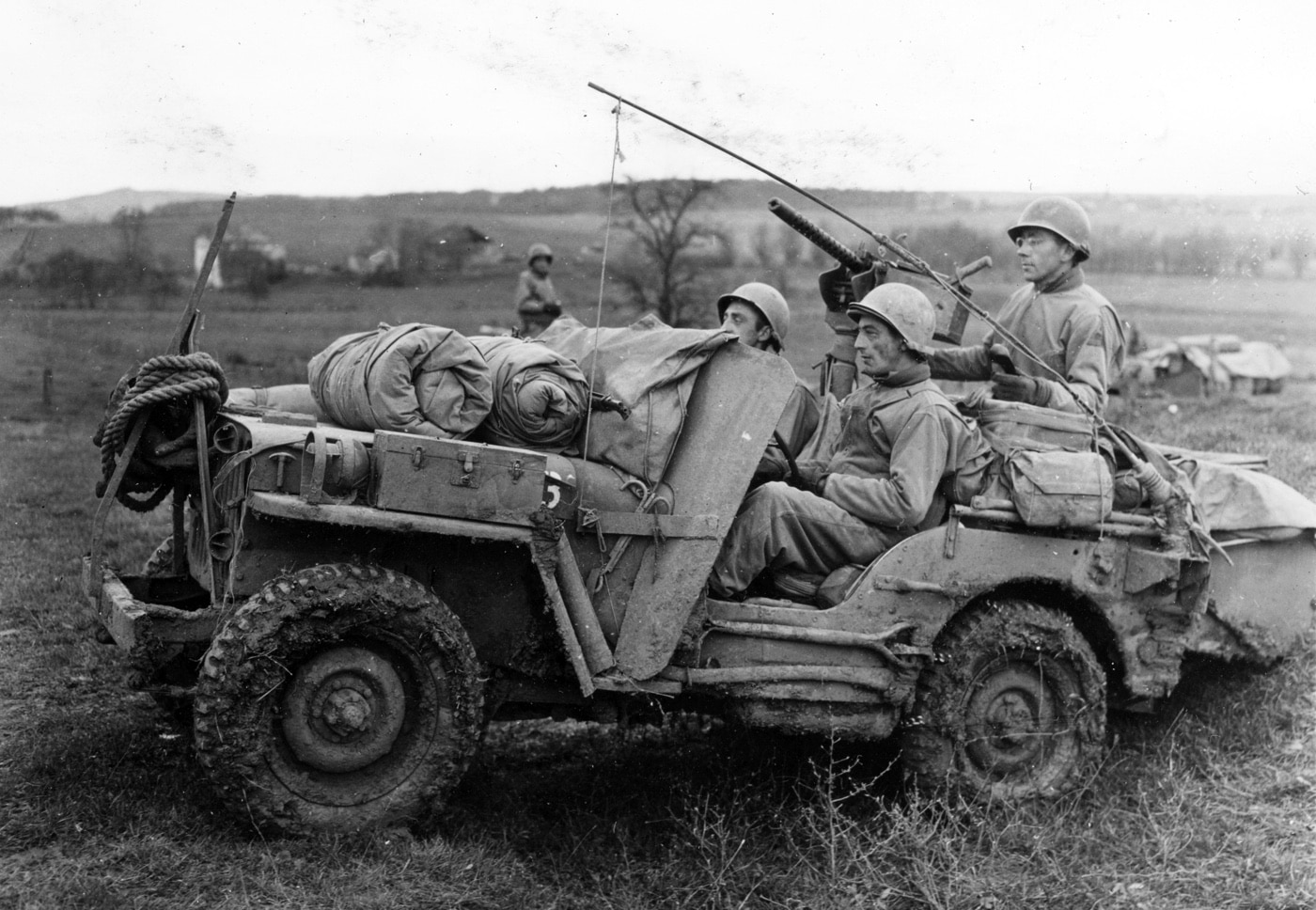
A wide variety of uses were made of the weapons with which the troop was equipped. Tripods for LMGs saw more use under the gun than the pedestal mounted in the ¼-ton 4 x 4. The .50 caliber MGs were seldom used on long patrol missions because of their weight, and the 60mm mortar proved to be one of the most valuable weapons in the troop. Personal arms of the men as provided for a mounted organization appeared to fit the needs of a dismounted unit. TSMGs were found to be valuable at the head of each patrol column. The carbine, although it was popular because of its light weight early in the campaigns, was eventually discarded whenever possible for the M1 rifle because of its greater range and striking power.
The mounted patrols consisted of three armored cars (M-8) and six jeeps. Three jeeps had a machine gun mounted on them as well as SCR 510 radios, and one jeep carried a 60mm mortar with a ¼ ton trailer attached to jeep with the platoon ammunition load and spare parts. In addition to this, another of the jeeps carried a BAR on an improvised mount. The platoon moved out with a machine gun jeep in the lead, carrying the scout section sergeant. This was followed at supporting distance by either the platoon leader’s armored car, or the platoon sergeants armored car and then the second jeep of the team. Usually, the platoon leader preferred to be in the lead team for better control. The platoon sergeants team followed in route column, with the MG jeep in the lead and this was followed by the armored car section sergeant’s team with the mortar jeep and trailer bringing up the rear of the column. When a half-track with mechanics and ammunition handler was attached to the platoon for an extended operation, this vehicle brought up the rear of the column.
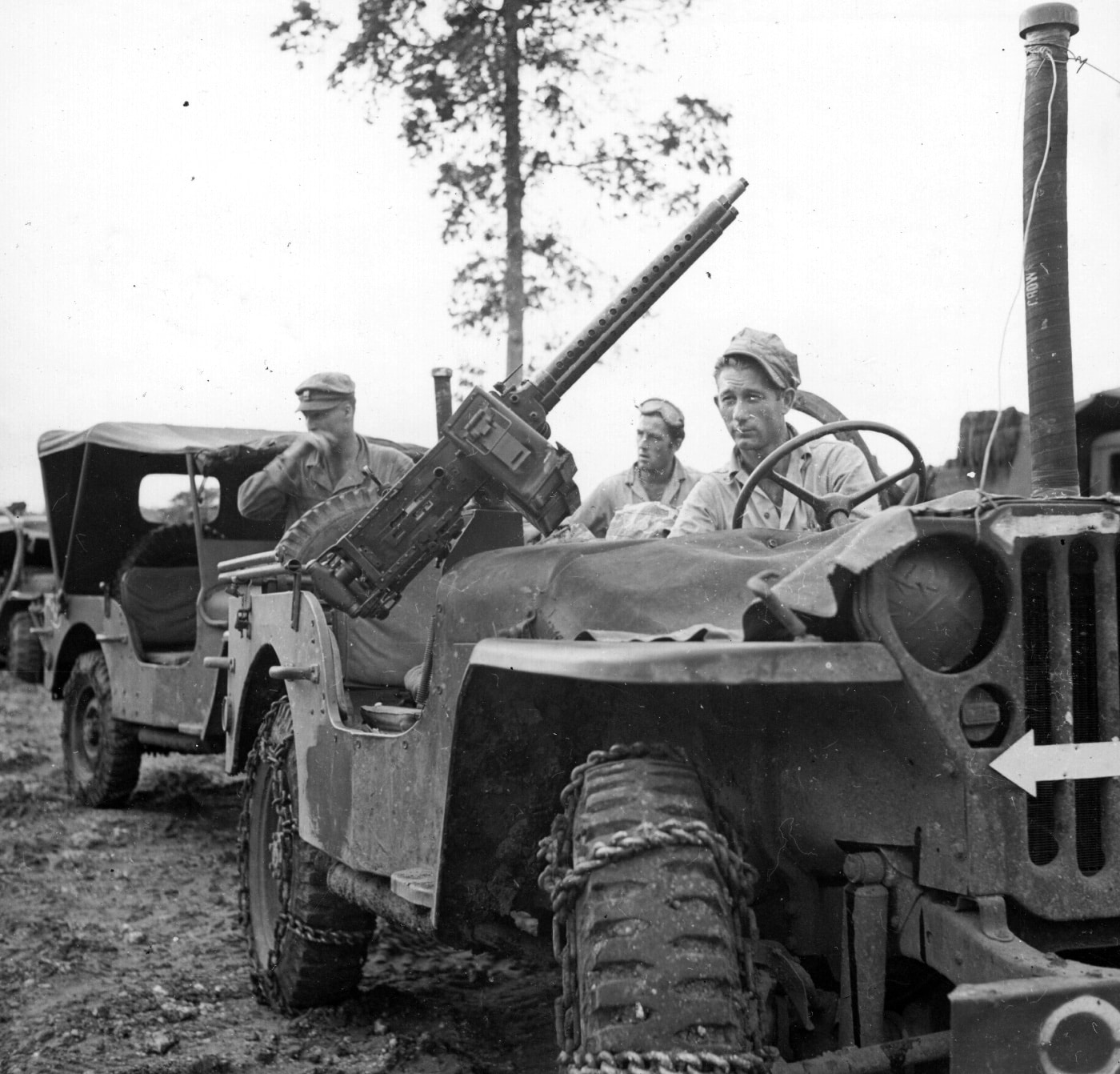
At night, great care was taken to find a covered area just off the road where the platoon could set up a perimeter defense. Vehicles were dispersed in a staggered circle with 37mm guns covering the road and the approaches to the area. Canister shot was loaded in these guns and MGs were dismounted and manned by their crew as was the 60mm mortar. Due to the number of vehicles and the few men in a platoon, it was difficult to maintain a tight perimeter. If enemy tanks were known to be in the vicinity, mines were set on the road ahead of the position.
With the 11th Cavalry in Germany
Many of the actions that involved armed Jeeps of recon troops combined actions on foot and in vehicles. While the machine guns mounted aboard the Jeep offered excellent firepower, the gunners were dangerously exposed in their positions.
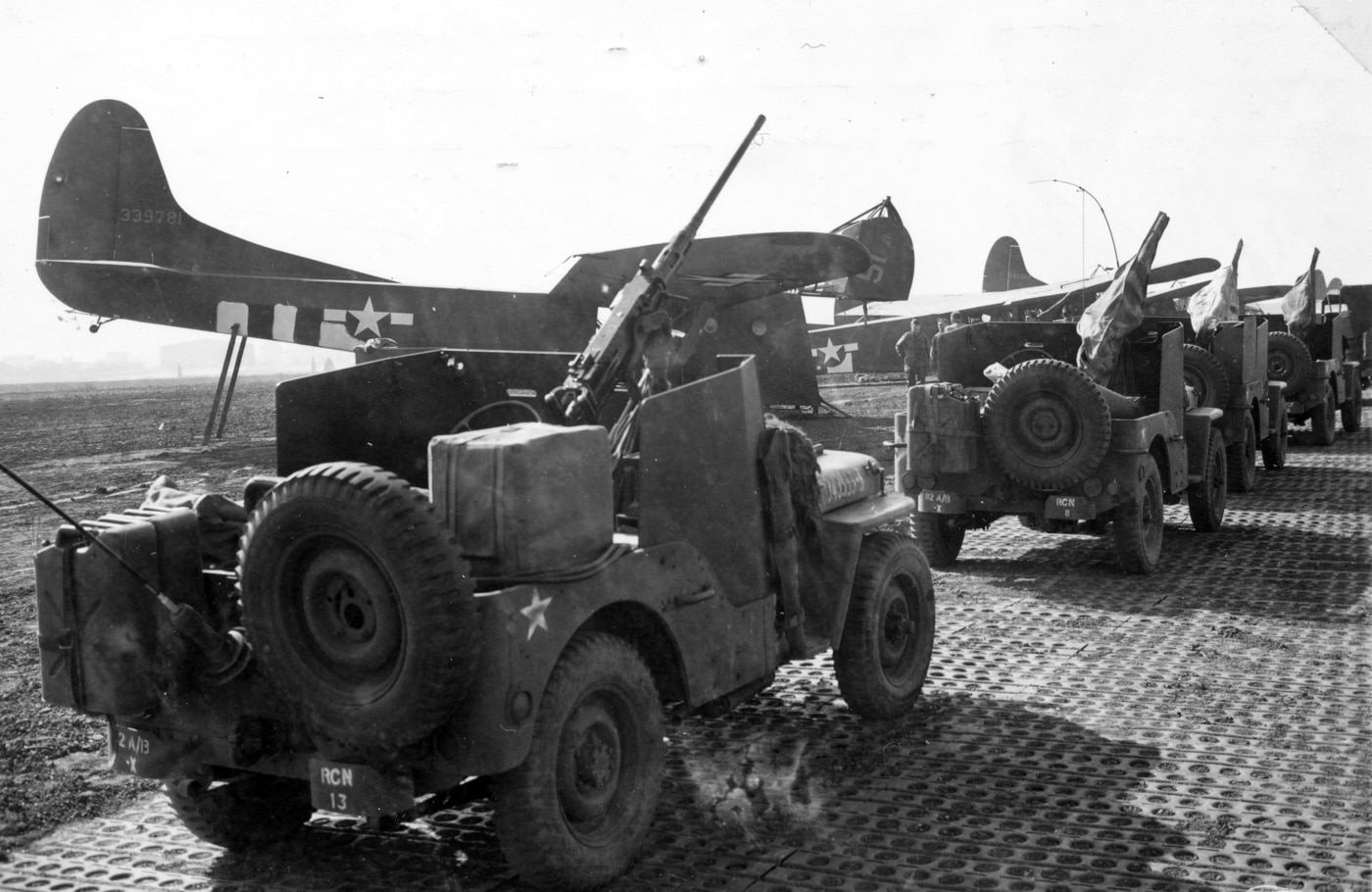
“With its Squadron pushing north from Huls to establish its screen to the Rhine, a platoon of the 36th Squadron was proceeding along its route approaching the town of Brusterhafe, Germany. A three-man patrol, including Cpl Earl R. Sheler and Tech 5 Grady B. Tharpe, with the mission of reconnoitering the route in advance of its platoon, suddenly encountered strong enemy positions. Tharpe immediately started back on foot to warn his platoon and had advanced about 100 yards when he was painfully wounded in the leg by enemy machine gun fire. He fell but struggled to his feet and continued with the message. Cpl Sheler, realizing the runner would not be able to get through unaided, left his covered position, manned the machine gun mounted on the jeep, and fired on the enemy positions until killed at his post. Tharpe, covered by Sheler’s fire, was able to get through and warn his platoon in time to prevent it from being ambushed. Cpl Sheler was posthumously awarded the Silver Star Medal for his valor and Tharpe received the Bronze Star Medal.”
The Legend of the Jeep
The images of Jeeps wheeling across the North African desert, their Browning .50-cal. machine guns blazing away at Nazi opponents, are forever burned into my mind from watching the ABC-TV series “The Rat Patrol” during the late 1960s. The show only lasted two seasons, but it captured the imagination of every guy who aspired to drive fast and shoot faster. The machine gun-armed Jeep was at the heart of it all — historical accuracy and good acting be damned; we couldn’t wait to see the next episode of the fictional desert patrol in action.

Through the years, the Jeep evolved and so did its armament. Machine guns were still mounted, along with increasingly heavier weapons, like 106mm recoilless rifles, and TOW anti-tank missile launchers. The legend lives on, but here is where it all started.
Editor’s Note: Please be sure to check out The Armory Life Forum, where you can comment about our daily articles, as well as just talk guns and gear. Click the “Go To Forum Thread” link below to jump in!
Join the Discussion
Read the full article here






